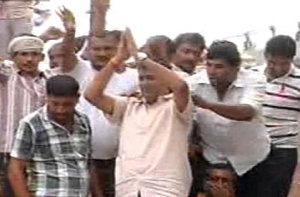 Lucknow, Sep 21: The Uttar Pradesh police arrested Bharatiya Janata Party (BJP) MLA Sangeet Som and BSP MLA Noor Salim Rana on Saturday even as Rajnath Singh’s scheduled visit to the riot-hit Muzaffarnagar was called off after the district administration advised him to cancel his visit.
Lucknow, Sep 21: The Uttar Pradesh police arrested Bharatiya Janata Party (BJP) MLA Sangeet Som and BSP MLA Noor Salim Rana on Saturday even as Rajnath Singh’s scheduled visit to the riot-hit Muzaffarnagar was called off after the district administration advised him to cancel his visit.
Som is accused of uploading a fake video that played a role in provoking communal tension in Muzaffarnagar and making inflammatory speeches.
SSP Deepak Kumar said that the BJP MLA was arrested from Salava village in his constituency Sardhana amid slogan-shouting by his supporters.
Though police said they had arrested Som, the supporters of the legislator claimed he had surrendered before Sardhana police.
Police has been put on alert in the town to deal with possible protests by BJP supporters.
Later on the day, a court also sent the arrested Suresh Rana to 14-day judicial custody.
In another development, the Muzaffarnagar district magistrate told Rajnath Singh on Saturday that his visit could furthur 'vitiate' the problems and advised him to cancel his visit to the riot-hit areas.
Later, Singh said, "it's unfortunate that my visit was not allowed by the district administration."
"There is emergency like situation in Muzaffarnagar, arrests of innocents must stop," he said.
Som's arrest comes a day after Uttar Pradesh Police took into custody BJP MLA Suresh Rana in Lucknow on charges of making provocative speech to incite riots in Muzaffarnagar.
A court in Muzaffarnagar had on Wednesday issued arrest warrants against 16 politicians and community leaders including Som, BSP MP Qadir Rana, BJP MLA Bhartendu Singh, BSP MLAs Noor Saleem and Maulana Jameel, Congress leader Saeeduzaman and BKU chief Naresh Tikait.
They are wanted for violating prohibitory orders and provoking communal tension by inflammatory speeches in different meetings (mahapanchayats) in the district, police said.
Som has been accused of allegedly uploading a fake video that provoked communal riots in Muzaffarnagar.
High drama had unfolded in front of UP Assembly on Wednesday with BJP leaders and workers, led by Uma Bharati, protested against the possible arrest of party MLA Som.
Facing criticism over failure to arrest several MLAs despite warrants being issued against them by a court in Muzaffarnagar, IG (Law and Order) R K Vishwakarma had said that the arrests were being "deliberately avoided" as the session of state Assembly was in progress.
The communal clashes in Muzaffarnagar and adjoining areas claimed 47 lives and displaced over 40,000 people.
The BJP has lashed out at the Samajwadi Party government alleging that its workers were being targeted and implicated in cases "without evidence".
The party also called for a bandh in western UP districts on Sunday.
The police have filed charges against Rana under sections 188 (violating section 144 that prevents a gathering of four or more people), 153 (a)(fanning communal feelings) and 335 (voluntarily causing serious hurt on provocation) of the Indian Penal Code.
About 15 other politicians from various parties have been slapped with similar charges, including BJP MLAs Sangeet Som, Hukum Singh and Bhartendu Singh.
Communal violence engulfed Muzaffarnagar, about 125 km from Delhi, in which 48 people were killed and at least 50,000 people were displaced.
Speculation was rife that the riots were an attempt to polarise communities ahead of the 2014 general elections.





Comments
Add new comment